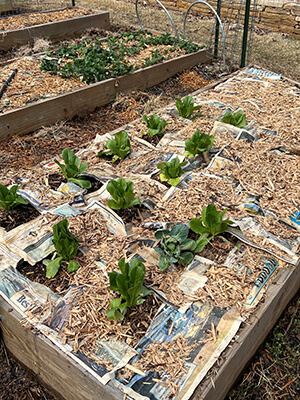
Raised beds make it easier to weed and harvest your crops.
With March temperatures bouncing erratically between freezing nights and 70-degree days, when’s the best time to plant your spring and summer vegetables? In North Georgia, UGA extension, garden experts and even the Old Farmer’s Almanac suggest planting them after April 15. That’s anyone’s best guestimate for the date of the last frost, so most years, it’s a good guideline.
By early March box retailers like Home Depot already stocked cool-season seedlings, such as romaine lettuce, celery, kale, cauliflower and broccoli. As early April rolls around, box retailer and area nurseries have added hybrid and heirloom tomatoes, eggplant, peppers, okra and other vegetables. And soon the weather will be warm enough to sow seeds directly into the garden.
But are you ready to grow? It’s easy to get ahead with your summer garden.
Start with raised beds, putting them in even before the date of the last frost. Use landscape timbers or rough-hewn lumber to build the sides, bracing from the inside to provide stability of the structure. Typically, people build them between 10 and 12 inches high. They’re great for minimizing back aches as you plant and cultivate your plants. If you’re not fond of bending over to weed and harvest, make them taller.
Fill the beds with good quality garden soil, not potting soil. Mix in a soil conditioner, organic matter and mushroom compost to add nutrients. If you’ve been composting share several shovels full in each bed. Go ahead and put in some slow-release fertilizer, even before planting.
Some people start seeds indoors under grow-lights, but the supply of vegetable seedlings is good at the beginning of the season, so you will have some excellent choices.
Remember that you can still plant salad greens, such as lettuces, spinach, arugula and mesclun before the last frost date and harvest until the nights get too warm and the plants begin to bolt. To pick greens, pinch off the lower leaves and allow the younger ones to mature. Your plants will produce much longer when harvested this way.
Once the soil has warmed – usually by the beginning of May – sow squash, melon, bean and cucumber seeds directly into the soil. Follow the instructions on the seed packets for planting depth and spacing. Be sure to check the “freshness date” on the seed packets you purchase to ensure they’re intended for the 2022 growing season.
When planting tomato seedlings, gently pinch off the lower leaves and then bury the now-bare-stemmed plants deeper into the ground to promote root growth. Pinch off early blooms to encourage the plant to use its energy to become established and have a stronger root system.
Peppers are fun to grow and offer many varieties including mild and colorful bells, sweet to hot banana peppers, and prolific jalapenos or “pants-on-fire” cayenne. They’ll reward you with a long harvest season, often producing peppers until the first hard frost of fall.
Plant a few herbs, such as basil, rosemary or dill. However, avoid any kind of mint in your garden. It is very invasive and can take over an area in just one season. If you want mint, plant it in a large container.
Garden tip: To keep weeds at bay in your vegetable garden, put down two to three sheets of newspaper between the seedlings, then apply a thin layer of mulch to keep the paper from blowing away. Water regularly and feed about every 10 days to two weeks with a water-soluble all-purpose fertilizer.
Photo: by Pamela A. Keene





